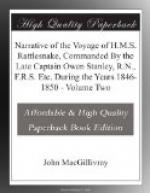KANGAROOS AND NEW BIRDS.
Several kangaroos or wallabies, the largest of which weighed forty pounds, were killed during our stay at Cape York. A kangaroo dog belonging to Captain Stanley made several fine runs, all of them unsuccessful however, as the chase was seldom upon open ground, and there was little chance of overtaking the kangaroo before it got into some neighbouring thicket where the dog could not follow it. This wallaby proved to be the Halmaturus agilis, first found at Port Essington, and afterwards by Leichhardt in Carpentaria. A singular bat of a reddish-brown colour was shot one day while asleep suspended from a branch of a tree; it belonged to the genus Harpyia, and was therefore a contribution to the Australian fauna.
Among many additions to the ornithological collections of the voyage were eight or nine new species of birds, and about seven others previously known only as inhabitants of New Guinea and the neighbouring islands.* The first of these which came under my notice was an enormous black parrot (Microglossus aterrimus) with crimson cheeks; at Cape York it feeds upon the cabbage of various palms, stripping down the sheath at the base of the leaves with its powerful, acutely-hooked upper mandible. The next in order of occurrence was a third species of the genus Tanysiptera (T. sylvia) a gorgeous kingfisher with two long, white, central tail-feathers, inhabiting the brushes, where the glancing of its bright colours as it darts past in rapid flight arrests the attention for a moment ere it is lost among the dense foliage.
(Footnote. Many of these have since been figured and described, with accompanying notes on their habits, etc., in the recently published Supplement to Mr. Gould’s Birds of Australia.)
I may next allude to Aplonis metallica—a bird somewhat resembling a starling, of a dark glossy green and purple hue, with metallic reflections—in connection with its singular nest. One day I was taken by a native to the centre of a brush, where a gigantic cotton-tree standing alone was hung with about fifty of the large pensile nests of this species.
NATIVE BIRD-NESTING.
After I had made several unsuccessful attempts to shoot down one of the nests by firing with ball at the supporting branch, the black volunteered to climb the tree, provided I would give him a knife. I was puzzled to know how he proposed to act, the trunk being upwards of four feet in diameter at the base, and the nearest branch being about sixty feet from the ground. He procured a tough and pliant shoot of a kind of vine (Cissus) of sufficient length to pass nearly round the tree, and holding one end of this in each hand and pressing his legs and feet against the tree, he ascended by a series of jerks, resting occasionally, holding on for half a minute at a time with one end of the vine in his mouth. At length he reached the branches and threw me down as many nests as I required. He afterwards filled the bag which he carried round his neck with the unfledged young birds, which on our return to the native camp on the beach were thrown alive upon the fire, in spite of my remonstrances, and when warmed through were devoured with great apparent relish by himself and his friends.




